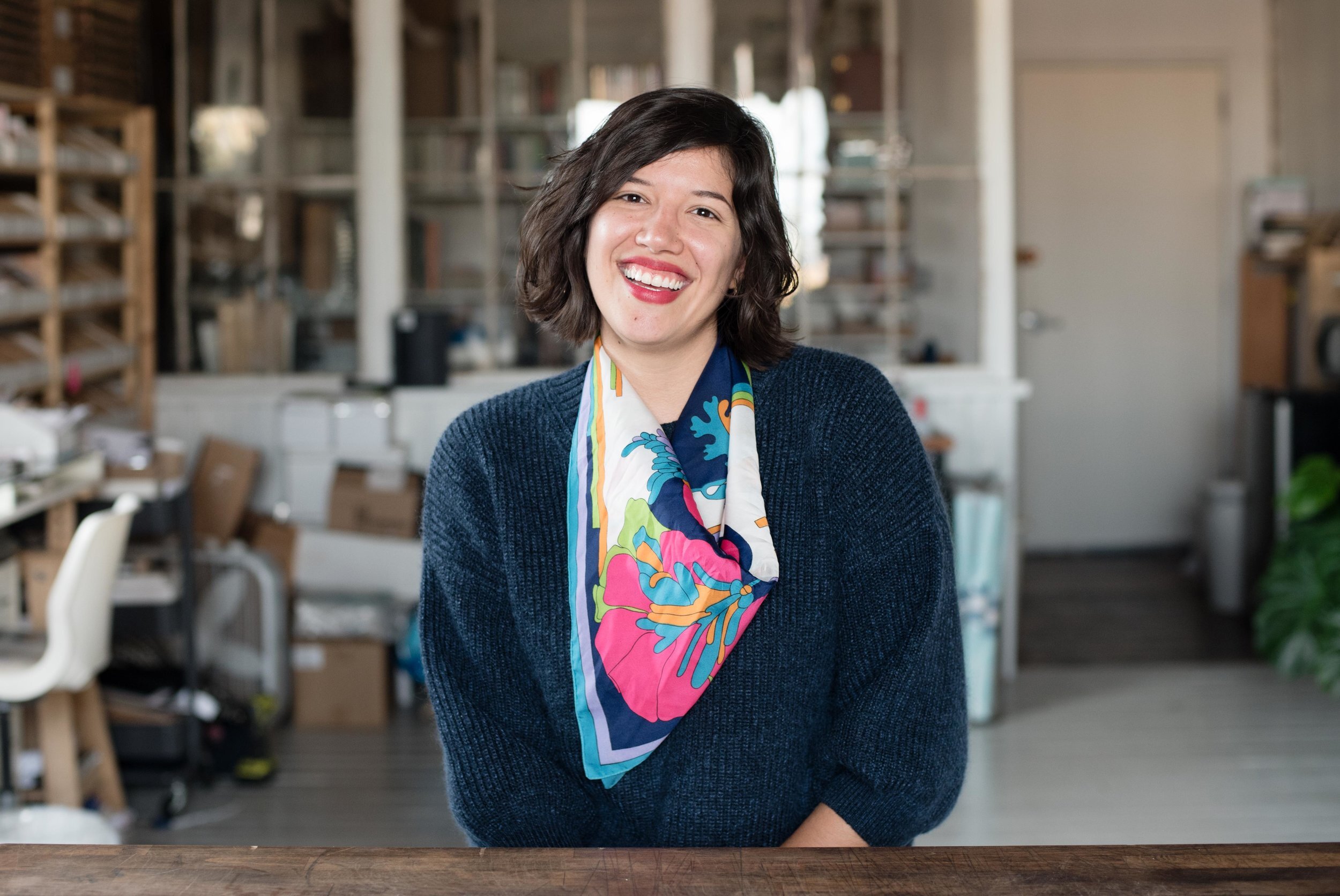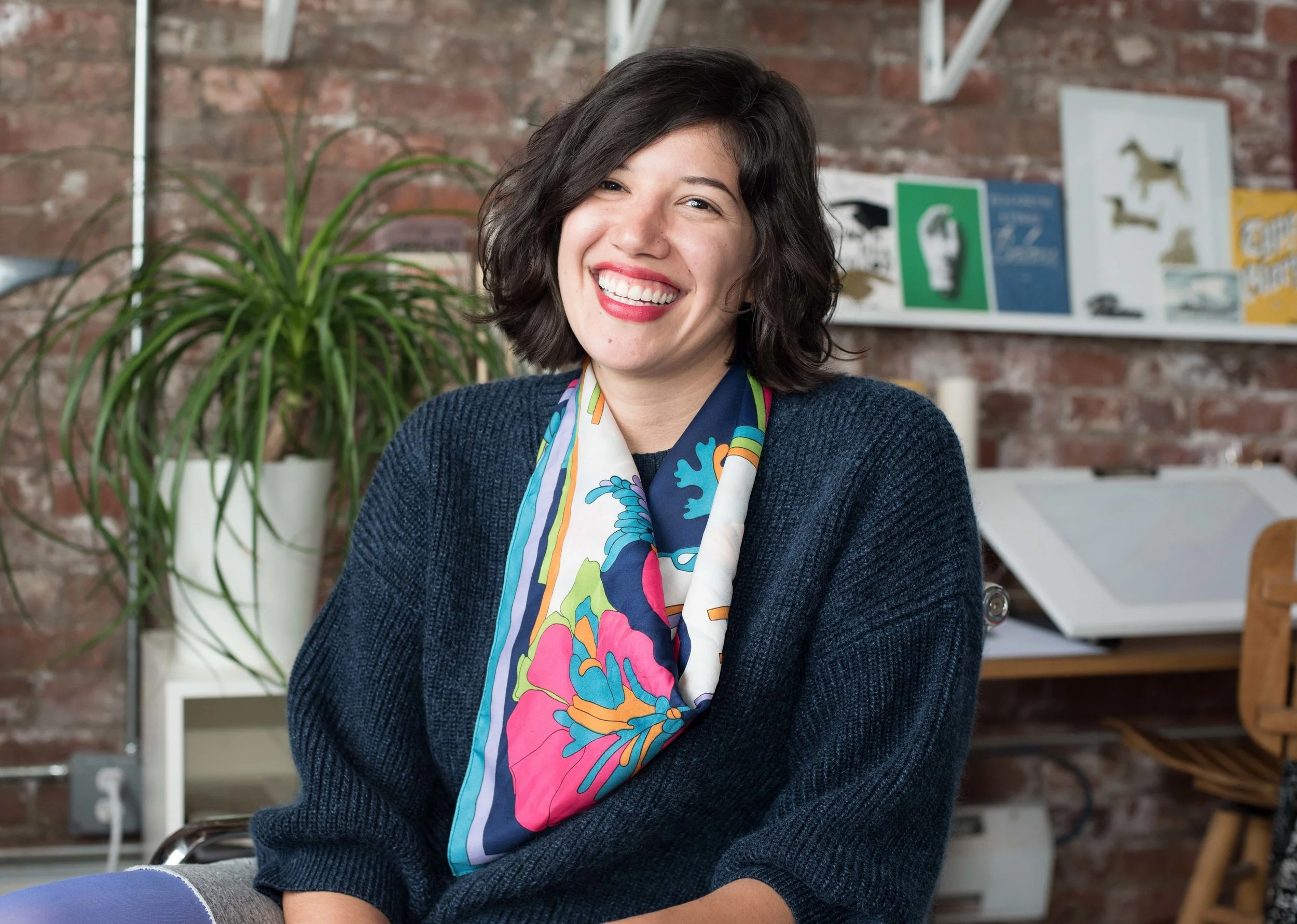Isabel Urbina Pena
We’re told never to judge a book by its cover, but that’s exactly what you need to do to appreciate Isabel Urbina Peña’s work. Isabel talks to us about her longtime love of reading, finding the courage to go freelance, and how she’s taken on sexism in the design industry.
June, 2017
You mentioned you were born in New York.
I was, but my family moved back to Venezuela when I was still a baby. Having a new baby, they wanted to be with family.
What led them to move to New York originally?
My parents are both architects, and my mom did her masters at university here. I think they stayed and worked for about five years after graduating, before having me and moving back. My sister was born in Venezuela.
I did all my schooling in Venezuela, including university. I studied graphic design and visual communications, and I was super focused on typography. I graduated in 2008 and moved to New York. It was one of those decisions that seemed awesome at the time, but it was really hard with the recession.
Why typography?
I've been thinking about this a lot lately. Initially, it was a love of reading that got me into it. My dad always gave me a lot of books growing up; he would never let me play video games or anything like that.
My parents also had a lot of artist friends, including one who was really into typography. He would speak about the importance of an invisible designer when designing books. You are creating something that no one will think about, but will allow them to read better. It’s amazing when you think about it. The width of the columns, the font, spacing: someone designed all of those things to make your experience of reading better. That really stuck with me.
I also used to do graffiti with my friends, growing up.
Just on the streets? Was it illegal?
Yes and yes. [Laughs] It was totally illegal. We got caught a couple of times but nothing happened. The law is different there.
What was it like arriving in New York on your own?
It was super strange. I knew a few places and companies, but I had no idea how to tackle things. The first job I got was an internship at the Museum of Natural History. I had freelanced at a museum in Venezuela and really loved it. I thought maybe I could go into exhibition design. In college, I did my thesis on astronomy; I designed a new visual language that would make astronomy easier for beginners to understand. That would lend itself to museums really well. But after a while, it became clear that it was a very corporate environment. It’s government-run, so it can be really hard to produce new work. Projects have to go through so many levels of approval. I was just an intern, but I had really high expectations of what I could achieve.
In Venezuela, I went to a school that was considered the best in Caracas. So it was sort of expected that, if you graduate from there, you will get an amazing job. If I had stayed I would have had everything laid out for me. It was a big leap to come to New York.
I had also started freelancing, doing small projects like logo designs and labels. I was also interviewing at design firms and eventually found a job at an amazing studio that did exhibition design, but also graphic and web design. It was great because it was a little bit of everything.
But during this time I still felt a need to continue studying. In 2010, I did a program called Type@Cooper at Cooper Union, which is a really prestigious school. A lot of amazing designers went there. It changed so much of the way I work, and how I see design. In order to do this course, I had to quit my job and go freelance again because I wanted to put everything into it. I was very lucky in finding clients, and had a couple of big jobs that helped me get by. When I finished Type@Cooper, I saw a Twitter posting about Random House hiring people.
Applying to Random House was such an intense process; I interviewed with a panel of five people. I really felt, though, that this was the job that I was meant to have. That it was the reason I came to New York, so i focused on doing my best. A couple of days after the interview, I got a call and they offered me the job.
It is really really hard to move up in a company that big and that actually ended up being one of the reasons I left. It was very structured. Everyone who works there has been there for so long, so there are very few spots that get opened up.
About a year ago, I decided to pull the carpet out from under myself and see what would happen. Since Cooper, I’d always been interested in pursuing type design full time. But it’s a very specific and small industry. There are very few jobs around. So I was back to freelance, although this time I had so much more experience.
One of the main things I do now is designing book covers, which is amazing. I still have a great relationship with Random House, and am actually working on one now for them.
“What is important to you? Spend time doing that.”
What is the process of designing a book cover?
Usually I get to read the book first. If it’s a new book, then I get a digital manuscript. If it’s a redesign of a book currently in the market, then I’ll get that version to read. I also get an information sheet that has the name of the author, a description of their style, some phrases from the book, and a synopsis. I also receive a list of current titles that give me an idea of where the publisher is hoping to place the book in the marketplace—like, what other books are they hoping to sit with?
Once I have an initial concept, I’ll send it through to the project director, then it goes to the editor, then to the publisher, and then the author. There are a lot of levels to go through.
It's really fun. I always try to read the whole book beforehand. You are interpreting the author's work, so it’s much easier to do when you have a full idea of what has been written. By the time I finish the book I usually have an idea of whether I want to design something completely original, or source an image and type. Sometimes I’ll do both and see what works best.
I love to read, so being able to convey the author's voice is something I take seriously. You are translating someone's art, so there is a lot of sensitivity in the process.
One of your other projects is called Yes Equal. Can you talk about that?
Of course! So, when I was starting out in design I used to go to a lot of conferences. There was one in particular called TypeCon that I attended with some of my Cooper classmates. We noticed that out of 13 speakers, only two were women. We personally knew of a few women who had submitted really amazing proposals, yet the programming was so male dominated, both in speakers and in subject matter.
We just started discussing this more and more, and it became a real topic of interest to me. I felt the urge to take action. I spoke to some men in high-level positions and they said that there weren't enough women wanting to do this work. I thought that was strange, so I wanted to see if it was actually true. I set up a website and asked women to add their names to it if they worked in the industry. I quickly had over 100 women. I published an article of my research. It’s interesting, because so many women study graphic design. It’s approximately 70 percent women. But then something happens after graduation. Seventy percent of the people getting the highest positions and winning awards are men. Men are on the boards of these firms, and running these organizations. Basically, I just passed the article around to my friends and asked them to send it on.
Two days after I sent it out, a very well-known lettering artist, Jessica Hische, tweeted about it. She has so many followers, and suddenly I had hundreds of women signing up to my site. I’m trying to figure out what the next step is now. It's something that's really important for me.
You’ve proven that there are women out there in this industry!
Totally. I also decided that I should be stepping up to speak at conferences since I’m out there saying more women should be doing this. I had to start with myself. I was so scared at first to talk in public, but it’s gotten easier. I’ve done two conferences now, and run some workshops.
Did you find you got a response at the conference from women in particular?
I feel like both women and men were excited to hear what I had to say. One of the first questions I was asked at a conference was about Yes Equal. It’s been amazing to see both parties interested.
What’s the best piece of advice you could give?
An important thing to me has been to take into consideration how I'm using my time, and why. What is important to you? Spend time doing that. If you have passion projects, then put in that extra time because it always pays off. People value hard work, and can see it in your work. It’s all you at the end of the day.
What does New York mean to you?
It’s two sides of a coin. Sometimes it feels like everything is possible, and other times it feels like nothing is enough. For me, it means finding a balance between those two things.
To learn more about Isabel and see her beautiful work, visit isabelurbinapena.com
Photography by Stephanie Geddes ©



